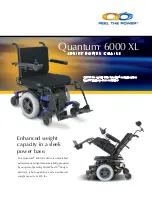
SECTION 3—SAFETY INSPECTION/TROUBLESHOOTING
29
Troubleshooting - Battery
Troubleshooting - Battery Charger
Wheelchair loses all power while
driving.
Bad Connection on wheelchair.
Turn power “Off”, wait 10 seconds and turn
power back “On”.
Check joystick connection.
Check battery connection and fuses.
Measure battery voltage.
Excessive forward motion when
braking
Stability lock not engaging properly.
Adjust the stability lock. Refer to Adjusting
the Stability Lock Setting on page 53.
SYMPTOM
PROBABLE CAUSE
SOLUTIONS
Batteries won’t charge.
Blown battery fuse or damaged
cables/connectors.
Batteries sat discharged too long.
Check cables and connectors for damage or
replace battery wiring harness. Replace
batteries.
Short Charge Time
One or both batteries may be bad (if
batteries charge up to soon).
Check each battery and replace if needed.
No power to wheelchair.
Bad connection or blown fuse. Check
Joystick connection.
Batteries are dead.
Check all connections and housings for dam-
age. If you have blown fuse a new battery
wiring harness must be purchased.
Check battery voltage and replace if neces-
sary.
Loose battery connections
Check battery cable connections, may have
vibrated loose when driving on rough terrain.
Corroded battery wiring connections.
Possible water, salt, or urine
damage.
Replace battery wiring harness.
E14 Error code.
Low voltage
Recharge or replace batteries.
SYMPTOM
PROBABLE CAUSE
SOLUTIONS
No LED’s on Charger
Charger not plugged into outlet.
Make sure the charger is plugged into the
outlet.
No AC power at outlet.
Check for AC power with digital volt meter.
Damaged power cord.
Check for damage on the power cord,
replace if damaged or send in for repair.
Charger LED’s burnt out.
Send charger to Invacare for repair.
Charger may have internal fuse that is
blown.
Send charger to Invacare for repair.
SYMPTOM
PROBABLE CAUSE
SOLUTIONS
















































